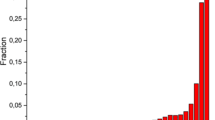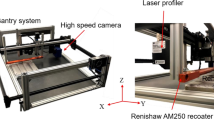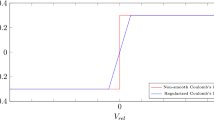Abstract
Powder spreading precedes creation of every new layer in powder bed additive manufacturing (AM). The powder spreading process can lead to powder layer defects such as porosity, poor surface roughness and particle segregation. Therefore, the creation of homogeneous layers is the first task for optimal part printing. Discrete element methods (DEM) powder spreading simulations are typically limited to a single layer and/or small number of particles. Therefore, results from such model configurations may not be generalized to multiple layer processes. In this study, a computationally efficient multi-layer powder spreading DEM simulation model is proposed. The model is calibrated experimentally using static Angle of Repose measurements. The adhesion model parameter, cohesive energy density is related to adhesive surface energy and strain energy release rate parameters. The model results show that interaction between particle and the powder spreading rake leads to noticeable variation in packing density, surface roughness, dynamic angle of repose (AOR), particle size distribution, and particle segregation. The powder model is experimentally validated using a recoater spreading rig to measure the dynamic AOR at spreading speeds consistent with recoating speeds and layer heights used in AM processes.

















Similar content being viewed by others
References
Babu SS, Love L, Dehoff R, Peter W, Watkins TR, Pannala S (2015) Additive manufacturing of materials: opportunities and challenges. MRS Bull 40(12):1154–1161
Körner C (2016) Additive manufacturing of metallic components by selective electron beam melting—a review. Int Mater Rev 61(5):361–377
Gürtler F-J, Karg M, Leitz K-H, Schmidt M (2013) Simulation of laser beam melting of steel powders using the three-dimensional volume of fluid method. Physi Proc 41:881–886
Khairallah SA, Anderson A (2014) Mesoscopic simulation model of selective laser melting of stainless steel powder. J Mater Process Technol 214(11):2627–2636
Khairallah SA, Anderson AT, Rubenchik A, King WE (2016) Laser powder-bed fusion additive manufacturing: physics of complex melt flow and formation mechanisms of pores, spatter, and denudation zones. Acta Mater 108:36–45
Körner C, Attar E, Heinl P (2011) Mesoscopic simulation of selective beam melting processes. J Mater Process Technol 211(6):978–987
Nandwana P, Kirka MM, Paquit VC, Yoder S, Dehoff RR (2018) Correlations between powder feedstock quality, in situ porosity detection, and fatigue behavior of Ti–6Al–4 V fabricated by powder bed electron beam melting: a step towards qualification. JOM 70(9):1686–1691
Haeri S (2017) Optimisation of blade type spreaders for powder bed preparation in additive manufacturing using DEM simulations. Powder Technol 321:94–104
Haeri S, Wang Y, Ghita O, Sun J (2016) Discrete element simulation and experimental study of powder spreading process in additive manufacturing. Powder Technol 306:45–54
Muñiz-Lerma J, Nommeots-Nomm A, Waters K, Brochu M (2018) A comprehensive approach to powder feedstock characterization for powder bed fusion additive manufacturing: a case study on AlSi7Mg. Materials 11(12):2386
Mindt HW, Megahed M, Lavery NP, Holmes MA, Brown SGR (2016) Powder bed layer characteristics: the overseen first-order process input. Metall Mater Trans A 47(8):3811–3822
Escano LI, Parab ND, Xiong L, Guo Q, Zhao C, Fezzaa K, Everhart W, Sun T, Chen L (2018) Revealing particle-scale powder spreading dynamics in powder-bed-based additive manufacturing process by high-speed x-ray imaging. Sci Rep 8(1):15079
Parteli EJ, Pöschel T (2016) Particle-based simulation of powder application in additive manufacturing. Powder Technol 288:96–102
Chen H, Wei Q, Wen S, Li Z, Shi Y (2017) Flow behavior of powder particles in layering process of selective laser melting: numerical modeling and experimental verification based on discrete element method. Int J Mach Tools Manuf 123:146–159
Nan W, Ghadiri M (2019) Numerical simulation of powder flow during spreading in additive manufacturing. Powder Technol 342:801–807
Meier C, Weissbach R, Weinberg J, Wall WA, Hart AJ (2019) Modeling and characterization of cohesion in fine metal powders with a focus on additive manufacturing process simulations. Powder Technol 343:855–866
Meier C, Weissbach R, Weinberg J, Wall WA, Hart AJ (2019) Critical influences of particle size and adhesion on the powder layer uniformity in metal additive manufacturing. J Mater Process Technol 266:484–501
Herbold E, Walton O, Homel M (2015) Simulation of powder layer deposition in additive manufacturing processes using the discrete element method. Lawrence Livermore National Lab (LLNL), Livermore, CA (United States)
Lee Y, Nandwana P, Zhang W (2018) Dynamic simulation of powder packing structure for powder bed additive manufacturing. Int J Adv Manuf Technol 96(1–4):1507–1520
Kloss C, Goniva C, Hager A, Amberger S, Pirker S (2012) Models, algorithms and validation for opensource DEM and CFD–DEM. Progr Comput Fluid Dyn Int J 12(2–3):140–152
Johnson KL, Kendall K, Roberts A (1971) Surface energy and the contact of elastic solids. Proc R Soc Lond A Math Phys Sci 324(1558):301–313
Hærvig J, Kleinhans U, Wieland C, Spliethoff H, Jensen AL, Sørensen K, Condra TJ (2017) On the adhesive JKR contact and rolling models for reduced particle stiffness discrete element simulations. Powder Technol 319:472–482
Parteli EJ, Schmidt J, Blümel C, Wirth K-E, Peukert W, Pöschel T (2014) Attractive particle interaction forces and packing density of fine glass powders. Sci Rep 4:6227
Stershic A, Simunovic S, Nanda J (2015) Modeling the evolution of lithium-ion particle contact distributions using a fabric tensor approach. J Power Sources 297:540–550
P.A. Cundall, O.D. Strack, A discrete numerical model for granular assemblies, geotechnique 29(1) (1979) 47-65
Coetzee C, Els D (2009) Calibration of granular material parameters for DEM modelling and numerical verification by blade–granular material interaction. J Terramech 46(1):15–26
Mitarai N, Nori F (2006) Wet granular materials. Adv Phys 55(1–2):1–45
Lee Y, Zhang W (2015) Mesoscopic simulation of heat transfer and fluid flow in laser powder bed additive manufacturing. In: International solid free form fabrication symposium, Austin, pp 1154–1165
Zielinski J, Vervoort S, Mindt H-W, Megahed M (2017) Influence of powder bed characteristics on material quality in additive manufacturing. BHM Berg- Huettenmaenn Monatsh 162(5):192–198
Barthel E (2008) Adhesive elastic contacts: JKR and more. J Phys D Appl Phys 41(16):163001
Packham D (1996) Work of adhesion: contact angles and contact mechanics. Int J Adhes Adhes 16(2):121–128
Maugis D, Barquins M (1980) Fracture mechanics and adherence of viscoelastic solids. In: Adhesion and adsorption of polymers. Springer, pp 203–277
Acknowledgements
This research was supported by the High-Performance Computing for Manufacturing Project Program (HPC4Mfg), managed by the U.S. Department of Energy Advanced Manufacturing Office within the Energy Efficiency and Renewable Energy Office. This research used resources of the Compute and Data Environment for Science (CADES) at the Oak Ridge National Laboratory. The authors thank Dr. John Turner for support in preparation of this manuscript.
Funding
This research is supported by the Office of Science of the U.S. Department of Energy under Contract No. DE-AC05-00OR22725.
Author information
Authors and Affiliations
Corresponding author
Ethics declarations
Conflict of interest
On behalf of all authors, the corresponding author states that there is no conflict of interest.
Appendix
Appendix
Simplified Johnson–Kendall–Roberts (SJKR) adhesion model is derived by simplification of its original JKR form for contact of elastic spheres with adhesion [21, 30]. It is applicable for modeling weak interaction between surfaces in contact which in our case describes a multitude of possible interaction mechanisms that result in a weak cementation between the particles. A general form of the SJKR model describes the force, Fc, resisting separation between particles as:
where \( \kappa \) is an effective cohesive stress, termed cohesion energy in SJKR model, and α is an effective contact area between the particles. Different selection of \( \kappa \) and α result in variations of the model. In principle, parameter \( \kappa \) can be related to the cohesive surface energy between the particles, \( \Delta \gamma \), which is more commonly used in the continuum mechanics problems for modeling strong and weak interactions. The critical contact surface radius, acr, and pull out force, Fcr, in the original JKR model are:
where R* denotes the effective particle radius of the contact of two particles, and E* denotes the effective elastic contact modulus, as:
Symbols Ri, Ei and νi denote radius, elastic modulus and Poisson’s ratio of particle i, respectively. Selecting the effective contact surface α as the area of the critical contact surface for the pull-out force, Fcr,
we have Eq. (10) after substitution of acr and Fcr from Eq. (5) and (6) into Eq. (9):
or equivalently
relate the two adhesive contact parameters κ and \( \Delta \gamma \).
Using Eq. (11), the nominal value of the cohesive energy density, κ, value of 3.6 × 106 J/m3 (= 3.6 × 107 erg/cm3) used in our model is converted to the adhesive surface energy, \( \Delta \gamma \), value of 5.35 × 10−2 mJ/m2. The calculated value for \( \Delta \gamma \) is fairly close to the value of 0.02 mJ/m2 for AOR = 29° and 0.06 mJ/m2 for AOR = 34° found in the literature for Ti–6Al–4V powder [16]. The value can be compared to the measured adhesive surface energy of 20–40 mJ/m2 in polymer materials [31].
An alternative theory for adhesion of particle was given by Maguis and Barquins [32]. Unloading of the spheres in contact was modeled as a crack propagation at the contact interface and the strain energy release rate for adhesion
Substituting acr and Fcr from Eqs. (5) and (6) into Eq. (12) for contact radius, a, and contact force, F, the cohesive energy density, κ, can be converted to the strain energy release. The cohesive energy density, κ, value of 3.6 × 106 J/m3 is converted to G value of 5.93 × 10−3 mJ/m2 that is in the one order of magnitude lower as the adhesive surface energy converted value above, 5.35 × 10−2 mJ/m2.
Rights and permissions
About this article
Cite this article
Lee, Y., Gurnon, A.K., Bodner, D. et al. Effect of Particle Spreading Dynamics on Powder Bed Quality in Metal Additive Manufacturing. Integr Mater Manuf Innov 9, 410–422 (2020). https://doi.org/10.1007/s40192-020-00193-1
Received:
Accepted:
Published:
Issue Date:
DOI: https://doi.org/10.1007/s40192-020-00193-1




